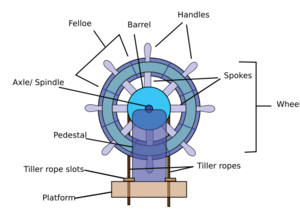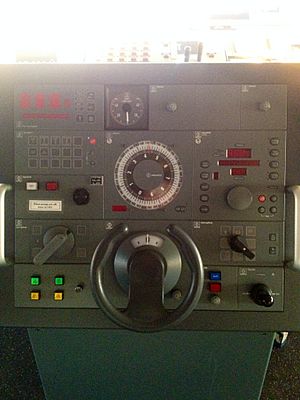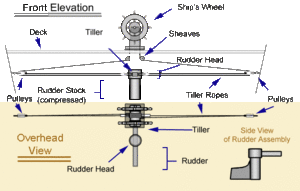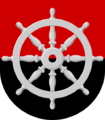Ship's wheel facts for kids

A ship's wheel or boat's wheel is a special device found on a ship or boat. Its main job is to help the helmsman (the person steering) control the vessel's direction. It works with other parts of the steering system, all together called the helm.
The ship's wheel is connected to a system that moves the ship's rudder. This system can be mechanical, electric, or hydraulic. When the wheel turns, it changes the angle of the rudder. This makes the ship turn left or right. On some modern ships, a simple switch or joystick has replaced the traditional wheel. This switch still controls the rudder, and a screen shows the helmsman where the rudder is pointing.
Contents
How Ship Wheels Began
Before the ship's wheel, sailors used a device called a tiller. This was a long bar connected directly to the top of the rudder. Another early steering tool was the whipstaff. This was a vertical stick that moved the tiller.
Historians are not completely sure when the ship's wheel was first used. However, many ships started using the wheel design around the early 1700s. It quickly became a popular way to steer large vessels.
Parts of a Ship's Wheel
A classic ship's wheel usually has eight wooden spokes. These spokes look like decorative posts and connect to a central wooden hub. The hub often has a brass plate on it. The axle, which helps the wheel turn, goes through a square hole in the center of the hub.
The outer part of the wheel, called the rim, is made of several sections. Each spoke goes through the middle of these sections, creating handles that stick out. One of these handles is special. It often has grooves that a helmsman can feel in the dark. This special handle is called the king spoke. When the king spoke points straight up, it means the rudder is perfectly straight.
Traditional ship's wheels, along with their axles and stands, could be quite tall. They were often made from strong tropical hardwoods like teak or mahogany. These woods are very durable and can handle salt water and constant use. Today, smaller boats might have wheels that look a bit different from these older designs.
How the Steering Mechanism Works
Older ship steering systems sometimes used two wheels connected by a wooden rod. This rod went through a large cylinder called a barrel or drum. A strong rope or chain, called a tiller rope, wrapped around this barrel. The rope then ran down through slots and connected to the ship's rudder at the back.
When the helmsman turned the wheels, the tiller rope would wind up in one direction or the other. This movement would pull the rudder to the left or right. For example, if a helmsman turned the wheel counter-clockwise (to the left), the rudder would swing to the left side of the ship. This would make the ship turn to the left.
Having two wheels allowed two people to steer at once. This was very helpful in bad weather when one person might not be strong enough to control the ship alone. When the wheel and rudder are turned as far as they can go, it's called being "hard over." So, a captain might shout "hard port" or "hard starboard" to turn the ship sharply.
Images for kids
-
The Commodore Boardroom at the Britannia Yacht Club features a unique ship's wheel table.
-
The ship's wheel and engine order telegraph on the USS LST-325.
-
U.S. Navy sailors by the ship's wheel aboard the USS Constitution.
-
A ship's wheel is shown in the coat of arms for Kitee, a town in Finland.
See also
 In Spanish: Rueda de timón para niños
In Spanish: Rueda de timón para niños
- Steering engine
- Steering wheel
- Tiller








